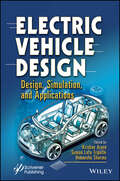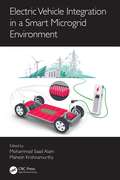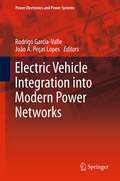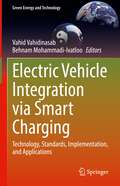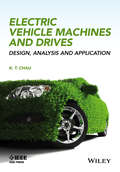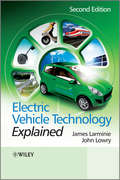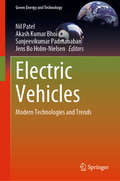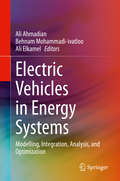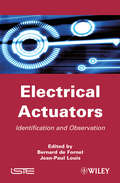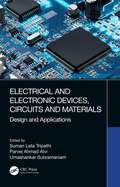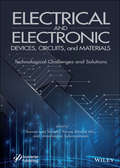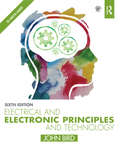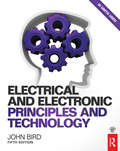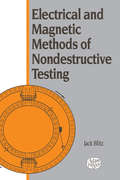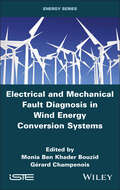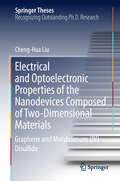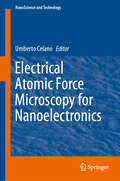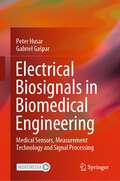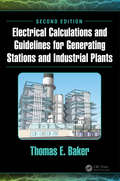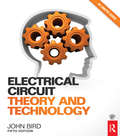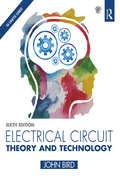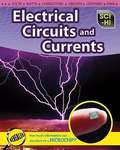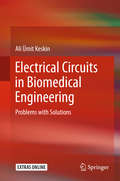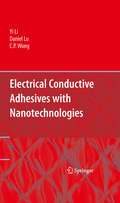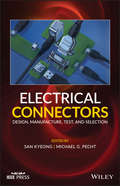- Table View
- List View
Electric Vehicle Design: Design, Simulation, and Applications
by Krishan Arora Suman Lata Tripathi Himanshu SharmaELECTRIC VEHICLE DESIGN This book will serve as a definitive guide to conceptual and practical knowledge about the design of hybrid electrical vehicles (HEV), battery electrical vehicles (BEV), fuel cell electrical vehicles (FCEV), plug-in hybrid electrical vehicles (PHEV), and efficient EV charging techniques with advanced tools and methodologies for students, engineers, and academics alike. This book deals with novel concepts related to fundamentals, design, and applications of conventional automobiles with internal combustion engines (ICEs), electric vehicles (EVs), hybrid electric vehicles (HEVs), and fuel cell vehicles (FCVs). It broadly covers vehicle performance, configuration, control strategy, design methodology, modeling, and simulation for different conventional and hybrid vehicles based on mathematical equations. Fundamental and practical examples of conventional electrical machines, advanced electrical machines, battery energy sources, on-board charging and off-board charging techniques, and optimization methods are presented here. This book can be useful for students, researchers, and practitioners interested in different problems and challenges associated with electric vehicles. Furthermore, in explaining the design methodology of each drive train, design examples are presented with simulation results.
Electric Vehicle Integration in a Smart Microgrid Environment
by Mohammad Saad Alam Mahesh KrishnamurthyElectric Vehicle Integration in a Smart Microgrid Environment The growing demand for energy in today’s world, especially in the Middle East and Southeast Asia, has been met with massive exploitation of fossil fuels, resulting in an increase in environmental pollutants. In order to mitigate the issues arising from conventional internal combustion engine-powered vehicles, there has been a considerable acceleration in the adoption of electric vehicles (EVs). Research has shown that the impact of fossil fuel use in transportation and surging demand in power owing to the growing EV charging infrastructure can potentially be minimalized by smart microgrids. As EVs find wider acceptance with major advancements in high efficiency drivetrain and vehicle design, it has become clear that there is a need for a system-level understanding of energy storage and management in a microgrid environment. Practical issues, such as fleet management, coordinated operation, repurposing of batteries, and environmental impact of recycling and disposal, need to be carefully studied in the context of an ageing grid infrastructure. This book explores such a perspective with contributions from leading experts on planning, analysis, optimization, and management of electrified transportation and the transportation infrastructure. The primary purpose of this book is to capture state-of-the-art development in smart microgrid management with EV integration and their applications. It also aims to identify potential research directions and technologies that will facilitate insight generation in various domains, from smart homes to smart cities, and within industry, business, and consumer applications. We expect the book to serve as a reference for a larger audience, including power system architects, practitioners, developers, new researchers, and graduate-level students, especially for emerging clean energy and transportation electrification sectors in the Middle East and Southeast Asia.
Electric Vehicle Integration into Modern Power Networks
by João A. Peças Lopes Rodrigo Garcia-ValleElectric Vehicle Integration into Modern Power Networks provides coverage of the challenges and opportunities posed by the progressive integration of electric drive vehicles. Starting with a thorough overview of the current electric vehicle and battery state-of-the-art, this work describes dynamic software tools to assess the impacts resulting from the electric vehicles deployment on the steady state and dynamic operation of electricity grids, identifies strategies to mitigate them and the possibility to support simultaneously large-scale integration of renewable energy sources. New business models and control management architectures, as well as the communication infrastructure required to integrate electric vehicles as active demand are presented. Finally, regulatory issues of integrating electric vehicles into modern power systems are addressed. Inspired by two courses held under the EES-UETP umbrella in 2010 and 2011, this contributed volume consists of nine chapters written by leading researchers and professionals from the industry as well as academia.
Electric Vehicle Integration via Smart Charging: Technology, Standards, Implementation, and Applications (Green Energy and Technology)
by Vahid Vahidinasab Behnam Mohammadi-IvatlooThis book brings together important new contributions covering electric vehicle smart charging (EVSC) from a multidisciplinary group of global experts, providing a comprehensive look at EVSC and its role in meeting long-term goals for decarbonization of electricity generation and transportation. This multidisciplinary reference presents practical aspects and approaches to the technology, along with evidence from its applications to real-world energy systems. Electric Vehicle Integration via Smart Charging is suitable for practitioners and industry stakeholders working on EVSC, as well as researchers and developers from different branches of engineering, energy, transportation, economic, and operation research fields.
Electric Vehicle Machines and Drives: Design, Analysis and Application (Wiley - IEEE)
by K. T. ChauA timely comprehensive reference consolidates the research and development of electric vehicle machines and drives for electric and hybrid propulsions• Focuses on electric vehicle machines and drives• Covers the major technologies in the area including fundamental concepts and applications• Emphasis the design criteria, performance analyses and application examples or potentials of various motor drives and machine systems • Accompanying website includes the simulation models and outcomes as supplementary material
Electric Vehicle Technology Explained
by James Larminie John LowryFully updated throughout, Electric Vehicle Technology, Second Edition, is a complete guide to the principles, design and applications of electric vehicle technology. Including all the latest advances, it presents clear and comprehensive coverage of the major aspects of electric vehicle development and offers an engineering-based evaluation of electric motor scooters, cars, buses and trains.This new edition includes:important new chapters on types of electric vehicles, including pickup and linear motors, overall efficiencies and energy consumption, and power generation, particularly for zero carbon emissionsexpanded chapters updating the latest types of EV, types of batteries, battery technology and other rechargeable devices, fuel cells, hydrogen supply, controllers, EV modeling, ancillary system design, and EV and the environmentbrand new practical examples and case studies illustrating how electric vehicles can be used to substantially reduce carbon emissions and cut down reliance on fossil fuelsfuturistic concept models, electric and high-speed trains and developments in magnetic levitation and linear motorsan examination of EV efficiencies, energy consumption and sustainable power generation.MATLAB® examples can be found on the companion website www.wiley.com/go/electricvehicle2eExplaining the underpinning science and technology, this book is essential for practicing electrical, automotive, power, control and instrumentation engineers working in EV research and development. It is also a valuable reference for academics and students in automotive, mechanical, power and electrical engineering.
Electric Vehicles: Modern Technologies and Trends (Green Energy and Technology)
by Nil Patel Akash Kumar Bhoi Sanjeevikumar Padmanaban Jens Bo Holm-NielsenThis book focuses on the latest emerging technologies in electric vehicles (EV), and their economic and environmental impact. The topics covered include different types of EV such as hybrid electrical vehicle (HEV), battery electrical vehicle (BEV), fuel cell electrical vehicle (FCEV), plug-in hybrid electrical vehicle (PHEV). Theoretical background and practical examples of conventional electrical machines, advanced electrical machines, battery energy sources, on-board charging and off-board charging techniques, and optimization methods are presented here. This book can be useful for students, researchers and practitioners interested in different problems and challenges associated with electric vehicles.
Electric Vehicles in Energy Systems: Modelling, Integration, Analysis, and Optimization
by Ali Elkamel Behnam Mohammadi-Ivatloo Ali AhmadianThis book discusses the technical, economic, and environmental aspects of electric vehicles and their impact on electrical grids and energy systems. The book is divided into three parts that include load modeling, integration and optimization, and environmental evaluation. Theoretical background and practical examples accompany each section and the authors include helpful tips and hints in the load modeling and optimization sections. This book is intended to be a useful tool for undergraduate and graduate students, researchers and engineers who are trying to solve power and engineering problems related electric vehicles.Provides optimization techniques and their applications for energy systems;Discusses the economic and environmental perspectives of electric vehicles;Contains the most comprehensive information about electric vehicles in a single source.
Electrical Actuators: Applications and Performance
by Bernard de Fornel Jean-Paul LouisThis helpful resource covers a large range of information regarding electrical actuators. In particular, robustness, a very problematic issue, is fully explored in a dedicated chapter. The text also deals with he estimate of non-measurable mechanical variables by examining the estimate of load moment, then observation of the positioning of a command without mechanical sensor. Finally, it examines the conditions needed to measure variables and real implementation of numerical algorithms. This is a key working resource for electrical engineers.
Electrical and Electronic Devices, Circuits and Materials: Design and Applications
by Suman Lata Tripathi Parvej Ahmad Alvi Umashankar SubramaniamThe increasing demand in home and industry for electronic devices has encouraged designers and researchers to investigate new devices and circuits using new materials that can perform several tasks efficiently with low IC (integrated circuit) area and low power consumption. Furthermore, the increasing demand for portable devices intensifies the search to design sensor elements, an efficient storage cell, and large-capacity memory elements. Electrical and Electronic Devices, Circuits and Materials: Design and Applications will assist the development of basic concepts and fundamentals behind devices, circuits, materials, and systems. This book will allow its readers to develop their understanding of new materials to improve device performance with even smaller dimensions and lower costs. Additionally, this book covers major challenges in MEMS (micro-electromechanical system)-based device and thin-film fabrication and characterization, including their applications in different fields such as sensors, actuators, and biomedical engineering. Key Features: Assists researchers working on devices and circuits to correlate their work with other requirements of advanced electronic systems. Offers guidance for application-oriented electrical and electronic device and circuit design for future energy-efficient systems. Encourages awareness of the international standards for electrical and electronic device and circuit design. Organized into 23 chapters, Electrical and Electronic Devices, Circuits and Materials: Design and Applications will create a foundation to generate new electrical and electronic devices and their applications. It will be of vital significance for students and researchers seeking to establish the key parameters for future work.
Electrical and Electronic Devices, Circuits, and Materials: Technological Challenges and Solutions
by Suman Lata Tripathi Parvej Ahmad Alvi Umashankar SubramaniamThe increasing demand for electronic devices for private and industrial purposes lead designers and researchers to explore new electronic devices and circuits that can perform several tasks efficiently with low IC area and low power consumption. In addition, the increasing demand for portable devices intensifies the call from industry to design sensor elements, an efficient storage cell, and large capacity memory elements. Several industry-related issues have also forced a redesign of basic electronic components for certain specific applications. The researchers, designers, and students working in the area of electronic devices, circuits, and materials sometimesneed standard examples with certain specifications. This breakthrough work presents this knowledge of standard electronic device and circuit design analysis, including advanced technologies and materials. This outstanding new volume presents the basic concepts and fundamentals behind devices, circuits, and systems. It is a valuable reference for the veteran engineer and a learning tool for the student, the practicing engineer, or an engineer from another field crossing over into electrical engineering. It is a must-have for any library.
Electrical and Electronic Principles and Technology
by John BirdThis practical resource introduces electrical and electronic principles and technology covering theory through detailed examples, enabling students to develop a sound understanding of the knowledge required by technicians in fields such as electrical engineering, electronics and telecommunications. No previous background in engineering is assumed, making this an ideal text for vocational courses at Levels 2 and 3, foundation degrees and introductory courses for undergraduates.
Electrical and Electronic Principles and Technology, 5th ed
by John BirdThis much-loved textbook introduces electrical and electronic principles and technology to students who are new to the subject. Real-world situations and engineering examples put the theory into context. The inclusion of worked problems with solutions really help aid your understanding and further problems then allow you to test and confirm you have mastered each subject. In total the books contains 410 worked problems, 540 further problems, 340 multiple-choice questions, 455 short-answer questions, and 7 revision tests with answers online. This an ideal text for vocational courses enabling a sound understanding of the knowledge required by technicians in fields such as electrical engineering, electronics and telecommunications. It will also be an excellent refresher for foundation and undergraduate degree students. It is supported by a companion website that contains solutions to the 540 questions in the practice exercises, formulae to help students answer the questions, multiple choice questions linked to each of the 23 chapters and information about the famous mathematicians and scientists mentioned in the book. Lecturers also have access to full solutions and the marking scheme for the 7 revision tests, lesson plans and illustrations from the book.
Electrical and Magnetic Methods of Nondestructive Testing
by Jack BlitzElectrical and Magnetic Methods of Nondestructive Testing presents a comprehensive account of the electrical and magnetic methods of nondestructive testing (NDT). The book begins with a discussion of the requirements for NDT and the criteria for the choice of a given method, followed by a summary of the general theory relating to electrical and magnetic testing techniques. Subsequent chapters discuss specific methods, including eddy current and flux-leakage techniques and microwave and potential drop methods. The appendix provides some useful programs for eddy current impedance analyses. These programs are in BASIC and can be run on PCs.
Electrical and Mechanical Fault Diagnosis in Wind Energy Conversion Systems
by Monia Ben Khader Bouzid Gérard ChampenoisWind energy conversion systems are subject to many different types of faults and therefore fault detection is highly important to ensure reliability and safety. Monitoring systems can help to detect faults before they result in downtime. This book presents efficient methods used to detect electrical and mechanical faults based on electrical signals occurring in the different components of a wind energy conversion system. For example, in a small and high power synchronous generator and multi-phase generator, in the diode bridge rectifier, the gearbox and the sensors. This book also presents a method for keeping the frequency and voltage of the power grid within an allowable range while ensuring the continuity of power supply in the event of a grid fault. Electrical and Mechanical Fault Diagnosis in Wind Energy Conversion Systems presents original results obtained from a variety of research. It will not only be useful as a guideline for the conception of more robust wind turbines systems, but also for engineers monitoring wind turbines and researchers
Electrical and Optoelectronic Properties of the Nanodevices Composed of Two-Dimensional Materials: Graphene and Molybdenum (IV) Disulfide (Springer Theses)
by Cheng-Hua LiuThis thesis focuses on the transport and magneto-transport properties of graphene p-n-p junctions, such as the pronounced quantum Hall effect, a well-defined plateau–plateau transition point, and scaling behavior. In addition, it demonstrates persistent photoconductivity (PPC) in the monolayer MoS2 devices, an effect that can be attributed to random localized potential fluctuations in the devices. Further, it studies scaling behavior at zeroth Landau level and high performance of fractional values of quantum Hall plateaus in these graphene p-n-p devices. Moreover, it demonstrates a unique and efficient means of controlling the PPC effect in monolayer MoS2. This PPC effect may offer novel functionalities for MoS2-based optoelectronic applications in the future.
Electrical Atomic Force Microscopy for Nanoelectronics (NanoScience and Technology)
by Umberto CelanoThe tremendous impact of electronic devices on our lives is the result of continuous improvements of the billions of nanoelectronic components inside integrated circuits (ICs). However, ultra-scaled semiconductor devices require nanometer control of the many parameters essential for their fabrication. Through the years, this created a strong alliance between microscopy techniques and IC manufacturing. This book reviews the latest progress in IC devices, with emphasis on the impact of electrical atomic force microscopy (AFM) techniques for their development. The operation principles of many techniques are introduced, and the associated metrology challenges described. Blending the expertise of industrial specialists and academic researchers, the chapters are dedicated to various AFM methods and their impact on the development of emerging nanoelectronic devices. The goal is to introduce the major electrical AFM methods, following the journey that has seen our lives changed by the advent of ubiquitous nanoelectronics devices, and has extended our capability to sense matter on a scale previously inaccessible.
Electrical Biosignals in Biomedical Engineering: Medical Sensors, Measurement Technology and Signal Processing
by Peter Husar Gabriel GašparDas grundlegende Kompendium führt in das zunehmend wichtiger werdende Thema der Biosginalverarbeitung ein. Der inhaltliche Aufbau orientiert sich an der Abfolge der diagnostischen Kette: von Sensorik, Signalverstärkung und -konditionierung über Signalabtastung und -digitalisierung, Methoden der Biosignalverarbeitung bis zu Auswertung und Diagnosevorschlag. Dabei liefert jedes Kapitel das entsprechende theoretische und methodische Wissen, behandelt Realisierungsalternativen und stellt Praxisbeispiele sowie die aktuell verfügbare Technik vor.
Electrical Calculations and Guidelines for Generating Stations and Industrial Plants
by Thomas E. BakerThe new edition aims to simplify the math, emphasize the theory, and consolidate the information needed by electrical engineers and technicians who support operations, maintenance, protective relay systems, and betterment projects for generating stations and industrial facilities. It begins with a cursory review of basic electrical phenomenon and then provides additional insights into electrical theory. Single phase and three phase electrical theory is explained in a simplified manner that is not presented in other books. All chapters have been expanded and updated, with the inclusion of an entirely new chapter.
Electrical Circuit Theory and Technology, 5th ed
by John BirdThis much-loved textbook explains the principles of electrical circuit theory and technology so that students of electrical and mechanical engineering can master the subject. Real-world situations and engineering examples put the theory into context. The inclusion of worked problems with solutions help you to learn and further problems then allow you to test and confirm you have fully understood each subject. In total the book contains 800 worked problems, 1000 further problems and 14 revision tests with answers online. This an ideal text for foundation and undergraduate degree students and those on upper level vocational engineering courses, in particular electrical and mechanical. It provides a sound understanding of the knowledge required by technicians in fields such as electrical engineering, electronics and telecommunications. This edition has been updated with developments in key areas such as semiconductors, transistors, and fuel cells, along with brand new material on ABCD parameters and Fourier’s Analysis. It is supported by a companion website that contains solutions to the 1000 questions in the practice exercises, formulae to help students answer the questions and information about the famous mathematicians and scientists mentioned in the book. Lecturers also have access to full solutions and the marking scheme for the 14 revision tests, lesson plans and illustrations from the book.
Electrical Circuit Theory and Technology (6th Edition)
by John BirdA fully comprehensive text for courses in electrical principles, circuit theory and electrical technology, providing 800 worked examples and over 1,350 further problems for students to work through at their own pace. This book is ideal for students studying engineering for the first time as part of BTEC National and other pre-degree vocational courses, as well as Higher Nationals, Foundation Degrees and first-year undergraduate modules.
Electrical Circuits and Currents
by Barbara A. SomervillWhat is St. Elmo's Fire? How does a steam turbine generate electricity? Which scientist developed the first battery? Electrical Circuits and Currents takes a look at how electricity works, and the forms that it takes. You will learn about electrical charges, series and parallel circuits, and materials that conduct electricity. You will even discover how to create your own schematic diagrams of electrical circuits! Wire it up and enter the always fascinating world of electrical circuits and currents! Sci-Hi is a visually stimulating series that takes learning science core curriculum to a whole new level! Each title in the series explores an area of life, physical, or earth science in a way that is both engaging and comprehensive. Topics include everything from chemical reactions to cell function and specialization. Features of the series include high-interest spreads, fantastic photos and artwork, science activities and projects, quizzes, reviews, timelines, and two or more pages of glossary words and further information. Book jacket.
Electrical Circuits in Biomedical Engineering
by Ali Ümit KeskinThis book presents a comprehensive and in-depth analysis of electrical circuit theory in biomedical engineering, ideally suited as textbook for a graduate course. It contains methods and theory, but the topical focus is placed on practical applications of circuit theory, including problems, solutions and case studies. The target audience comprises graduate students and researchers and experts in electrical engineering who intend to embark on biomedical applications.
Electrical Conductive Adhesives with Nanotechnologies
by Yi Grace Li Daniel Lu C. P. Wong"Electrical Conductive Adhesives with Nanotechnologies" begins with an overview of electronic packaging and discusses the various adhesives options currently available, including lead-free solder and ECAs (Electrically Conductive Adhesives). The material presented focuses on the three ECA categories specifically, Isotropically Conductive Adhesives (ICAs) Anisotropically Conductive Adhesives/Films (ACA/ACF) and Nonconductive Adhesives/Films (NCA/NCF). Discussing the advantages and limitations of each technique, and how each technique is currently applied. Lastly, a detailed presentation of how nano techniques can be applied to conductive adhesives is discussed, including recent research and development of nano component adhesives/nano component films, their electrical properties, thermal performance, bonding pressure and assembly and reliability.
Electrical Connectors: Design, Manufacture, Test, and Selection (Wiley - IEEE)
by Michael G. Pecht San KyeongDiscover the foundations and nuances of electrical connectors in this comprehensive and insightful resource Electrical Connectors: Design, Manufacture, Test, and Selection delivers a comprehensive discussion of electrical connectors, from the components and materials that comprise them to their classifications and underwater, power, and high-speed signal applications. Accomplished engineer and author Michael G. Pecht offers readers a thorough explanation of the key performance and reliability concerns and trade-offs involved in electrical connector selection. Readers, both at introductory and advanced levels, will discover the latest industry standards for performance, reliability, and safety assurance. The book discusses everything a student or practicing engineer might require to design, manufacture, or select a connector for any targeted application. The science of contact physics, contact finishes, housing materials, and the full connector assembly process are all discussed at length, as are test methods, performance, and guidelines for various applications. Electrical Connectors covers a wide variety of other relevant and current topics, like: A comprehensive description of all electrical connectors, including their materials, components, applications, and classifications A discussion of the design and manufacture of all parts of a connector Application-specific criteria for contact resistance, signal quality, and temperature rise An examination of key suppliers, materials used, and the different types of data provided A presentation of guidelines for end-users involved in connector selection and design Perfect for connector manufacturers who select, design, and assemble connectors for their products or the end users who concern themselves with operational reliability of the system in which they’re installed, Electrical Connectors also belongs on the bookshelves of students learning the basics of electrical contacts and those who seek a general reference with best-practice advice on how to choose and test connectors for targeted applications.
